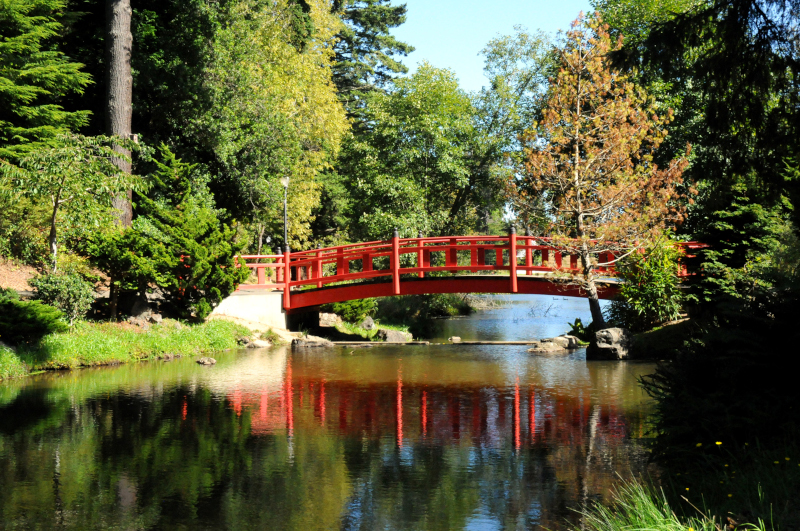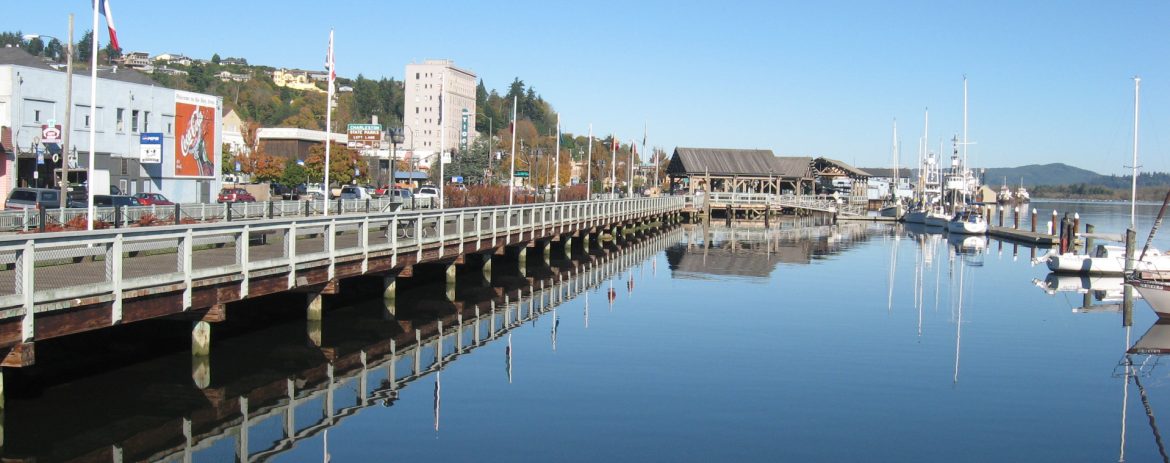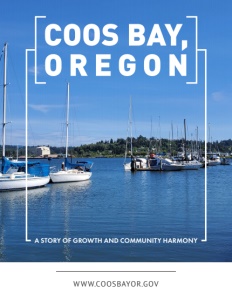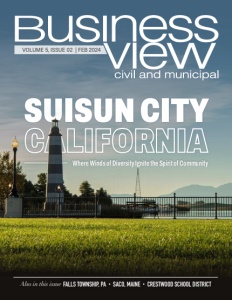Coos Bay, Oregon
Coos Bay: A Story of Growth and Community Harmony
Oregon’s largest coastal city expertly balances economic development, natural resources, and a thriving tourism sector to create a vibrant, sustainable future.
Coos Bay, Oregon, a gem on the Pacific Northwest coast, is more than just a picturesque town. As the largest city on the Oregon coast, it boasts a unique blend of natural beauty and economic vibrancy. Mayor Joe Benetti, with palpable pride, highlights the town’s defining features. “We’re not just a scenic destination; we’re a hub of diverse economic activities,” he says. The city’s natural harbor, recognized as the largest deep-water port between San Francisco and Seattle, is a cornerstone of its economic landscape.
Mayor Benetti emphasizes Coos Bay’s multifaceted economy. “Tourism is a significant economic driver here, contrary to what some might think.” This is complemented by a bustling business sector, with over 3000 businesses thriving in the city. The Port of Coos Bay, a significant player in the area, spearheads larger business initiatives. Education and transportation also play crucial roles in the local economy. “Southwestern Community College adds an educational dimension to our town, while our unique airport, the only one providing commercial air service on the Oregon coast, features a business park,” he elaborates.
Coos Bay: A Hub of Economic Resilience and Community Spirit
As Coos Bay navigates through various economic challenges, including the impact of COVID-19, the city’s leadership reveals a commitment to fostering a robust local business environment. The city manager, Nichole Rutherford, outlines proactive measures to bolster Coos Bay’s commercial sector. “Our urban renewal agency has been pivotal,” she explains. “Through our improvement program grant, we’ve assisted a wide range of businesses, offering grants ranging from $25,000 to $150,000.” This initiative reflects Coos Bay’s determination to enhance its commercial appeal, offering tangible support to businesses seeking to improve their physical spaces.
The city’s response to the pandemic showcases its agility and community focus. Rutherford recalls, “During COVID-19, we launched small-scale initiatives, like distributing gift cards to support our local restaurants. This effort, though modest, had a significant impact, especially during the holidays.” This initiative, a collaboration with the visitor and convention bureau, underscores Coos Bay’s knack for fostering partnerships beyond traditional boundaries.
Council President Lucinda DiNovo adds to this narrative. “Our commitment goes beyond city limits,” she states. “Coos Bay thrives on collaboration and partnership, not just within the city but with neighboring areas and organizations.” She highlights the role of the Mill Casino Hotel and RV Park, owned by the Coquille Indian Tribe, in enriching the local economy and cultural landscape. “We’re on the ancestral homelands of three tribes,” DiNovo notes, underlining the city’s deep-rooted connection with its indigenous heritage.

Revitalizing Coos Bay: A Vision for the Future
In Coos Bay, urban renewal and community-centric planning take center stage. Mayor Benetti sheds light on the city’s approach to revitalizing its various neighborhoods, each with unique character and potential. “Our goal is to enhance the downtown experience while respecting the distinctiveness of each area,” he explains. The city’s multifaceted plan focuses on areas like the Empire District, the traditional downtown, and Front Street, each earmarked for specific developments.
Mayor Benetti highlights the specifics of these plans. “We’re actively working on making our downtown more vibrant. Over the past six years, we’ve invested 1.4 million dollars in improvement grants,” he states. This strategic financial commitment is beginning to bear fruit, particularly on Front Street, where a recent allocation of $500,000 marks the start of an exciting new phase. “This initiative complements the private development that’s been taking place, with an investment of around 3 million dollars in the last couple of years,” he adds.
The city’s efforts go beyond mere beautification. Front Street, as Mayor Benetti points out, is integral to Coos Bay’s working waterfront, home to long standing businesses like Sause Bros., Inc. a tugboat operation with an 80-year history in ocean towing and shipbuilding. The Empire district, leading out to the ocean beaches and the Charleston fishing village, is also transforming. “We’re in the process of crafting a blueprint plan for Empire. It’s a vital link to our fishing industry and a gateway to our stunning beaches,” he remarks.
Addressing the Housing Challenge in Coos Bay
The conversation shifts to a critical issue facing many American cities: the housing shortage. Mayor Benetti acknowledges this as a pressing concern in Coos Bay, highlighting the city’s proactive steps to address it. “Housing is indeed one of our top priorities,” he affirms. Collaborative efforts with the state Department of Land Conservation and Development have led to significant developments, including a project near the local hospital. This initiative, supported by a grant, promises to deliver around 200 units on a 16-acre site.
The Mayor details other housing projects to diversify Coos Bay’s residential landscape. “We’re in the midst of another project that could add 400 workforce homes to our city,” he notes. The fluctuating dynamics of interest rates pose challenges, but the city is exploring ways to mitigate these, such as seeking grants for infrastructure development. “Our goal is to keep housing affordable while meeting the demand,” Mayor Benetti emphasizes.
The issue of workforce housing, particularly for essential workers like paramedics and police officers, is also on the city’s agenda. Mayor Benetti reveals, “We’ve been discussing workforce housing extensively. It was a goal two years ago and remains a goal today.” The city is considering innovative solutions, such as partnering with the local hospital which is providing a 16 acre parcel of land. “We aim to make it easier for our workforce to live and work in the area,” he explains.
A unique aspect of Coos Bay’s approach to fostering housing development is the absence of system development charges, a policy Mayor Benetti is keen to highlight. “By not imposing these charges, we hope to attract more development, especially in the housing sector,” he states. This strategy is part of a broader effort to make Coos Bay an attractive destination for residents and developers alike, balancing the need for growth with the city’s commitment to affordability and accessibility.

Tourism: Coos Bay’s Thriving Economic Engine
Tourism in Coos Bay has seen a remarkable upsurge, becoming a vital part of the city’s economic fabric. Council President DiNovo, who also chairs the local destination marketing organization, delves into the city’s strategic efforts to bolster tourism. “Our focus on tourism is intentional,” she states. “When Mayor Benetti and I were elected, we were committed to enhancing tourism’s role in our economy.” This commitment is evident in the increased funding allocated to the Visitor and Convention Bureau, reflecting a deep understanding of tourism’s potential impact on the city.
DiNovo outlines the collaborative structure underpinning the tourism initiatives in Coos Bay. “The city’s efforts in tourism are a collective endeavor,” she explains. The Visitor and Convention Bureau, an intergovernmental agreement involving Coos Bay, North Bend, the Coquille Indian Tribe, and portions of Charleston, emphasizes this collaborative spirit. “Our budget was smaller than our northern neighbors, but by increasing our contribution, we’ve made significant strides in representing our region effectively,” she adds.
The impact of these efforts on the local economy is substantial. DiNovo shares some striking statistics: “In 2022, direct visitor spending in Coos County soared to $295.9 million, a 36% increase from the previous year.” Coos Bay, North Bend, and Charleston alone accounted for $137.2 million of this spending. These figures underscore the economic significance of tourism in the region.
Furthermore, DiNovo highlights the unique role of the local tribes in bolstering the tourism sector. “The Coquille Indian Tribe and the Confederated Tribes of Coos, Lower Umpqua, and Siuslaw Indians, with their tourism facilities, contribute significantly to our economy,” she notes. This tribal involvement enriches the cultural landscape and injects vital funds into the local tourism economy.
In Coos Bay, tourism is not just an economic sector; it’s a cornerstone of the community’s livelihood. “Our largest regional employers are directly linked to tourism,” DiNovo points out. “This fact alone speaks volumes about the role of tourism in our community.” The synergy between the city’s initiatives, tribal contributions, and natural attractions like the Oregon Dunes National Recreation Area has positioned Coos Bay as a dynamic and flourishing tourist destination.
Charting Coos Bay’s Path Forward: Perspectives for 2024
As Coos Bay strides boldly into 2024, its leaders share their visions and priorities for the city’s future. Mayor Benetti emphasizes the importance of striking a balance in Coos Bay’s development strategy. “Economic development remains a key focus,” he asserts. “This includes enhancing our infrastructure, which is fundamental for economic growth and maintaining the city’s charm.” Tourism, a significant driver of the local economy, continues to be a priority, along with nurturing the city’s natural resources. “Our fishing and timber industries are essential to our economy,” he notes. The Mayor also highlights the strategic role of the local airport in connecting Coos Bay to significant cities and fostering a unique market for remote workers and second-home owners.
City Manager Rutherford points out the importance of connectivity and walkability in the city’s development plans. “Our goal is to create a vibrant, active downtown core, bridging different parts of the city,” she explains. Housing remains a pressing issue, with plans underway to address the needs of a growing population. “We’re looking at urban growth boundary adjustments and focusing on building both single-family homes and low-income multifamily units,” she adds. Rutherford also mentions the potential development of industrial lands in the Eastside and Empire areas, contingent on infrastructure improvements.
Council President DiNovo underscores the significance of collaboration and partnerships in driving Coos Bay’s growth. She highlights the vital role of Bandon Dunes Golf Resort, not just as a tourist attraction but also as a pivotal contributor to the community’s well-being. “Their partnership has been instrumental in ensuring quality air service, benefiting residents and visitors,” she remarks. This collaboration is a prime example of how local businesses can significantly impact the broader community.
As 2024 unfurls, Coos Bay’s leaders exhibit a clear vision for the city — a blend of economic development, community connectivity, and sustainable use of natural resources, all woven together with a strong collaboration thread. This forward-thinking approach positions Coos Bay as a picturesque coastal town and a dynamic community poised for continued growth and success.
AT A GLANCE
Coos Bay, Oregon
What: Oregon’s largest coastal city, known for its natural beauty, economic diversity, and vibrant community
Where: Coos Bay, Oregon, USA
Website: https://www.coosbayor.gov/home
PREFERRED VENDORS
Southwest Oregon Regional Airport – AirportBusiness@flyoth.com


